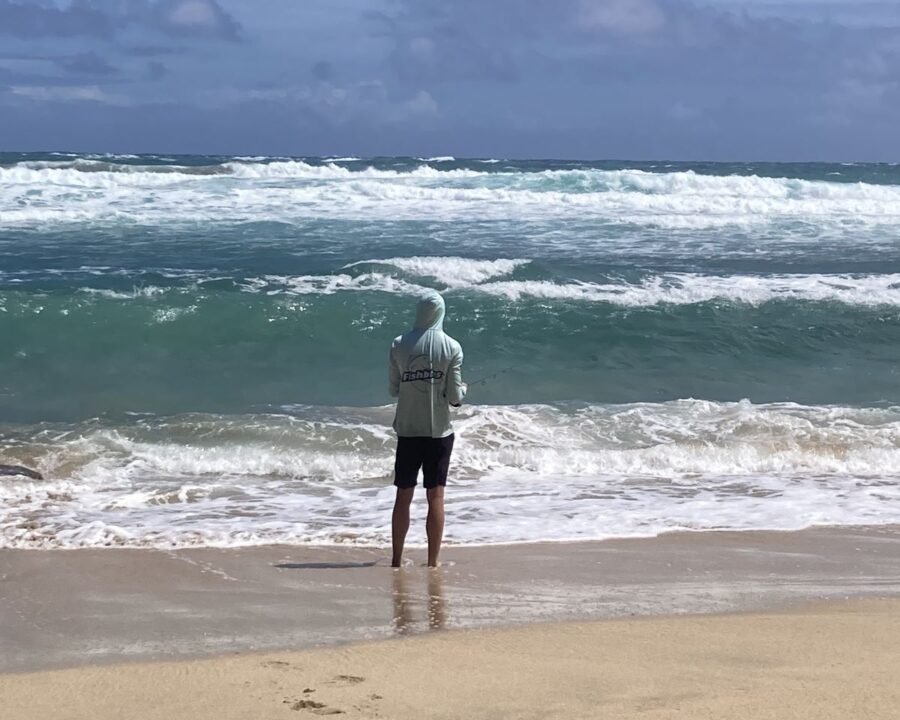What’s Too Big? – Surf Fishing In Big Surf

You pull up to your favorite stretch of beach at sunrise, rod in hand and tackle box ready. But instead of a calm, inviting shoreline, you’re greeted by chest-high waves pounding the beach. You pause and ask yourself: Is it even worth casting today? If you’ve ever wondered about surf fishing in big surf, you’re not alone.
The question of “how big is too big” when it comes to surf fishing is one every angler faces. In this article, we’ll explore what that means in real-world terms and how you can make the call between fishing smart and packing it in. For a deeper dive into conditions overall, check out my guides on planning for best conditions and how wave height affects surf fishing.
Understanding Big Surf Conditions
Whether or not the surf is too big depends on a few factors:
- Your experience level
- Your gear
- Your target species
- The beach and structure you’re fishing
A 4-foot swell may be fine for one angler and impossible for another. Clean, low surf with a long period swell is much more manageable than short, sloppy wind-driven waves. That said, the sweet spot for most SoCal surf fishing sits in the 1–3 ft. range. Once waves hit the 4–5 ft. zone, it takes skill, strategy, and sometimes heavier gear to even make it worth trying. Above that? It’s likely time to change plans. Below, we’ll talk more about determining if surf fishing in big surf is worth it or not on any given day as we look into some more conditions.
How Big Surf Impacts Your Fishing
When the waves are up, the water gets wild:
- Turbulence stirs sand, reduces visibility, and displaces baitfish.
- Seaweed gets spun up and tangled around your line.
- Current becomes more aggressive, sweeping your rig out of position.
- Presentation becomes difficult—keeping bait in the strike zone is a challenge.
- Safety becomes a concern. No fish is worth putting yourself in danger.
When strong surf meets a side current and a salad bar of seaweed, it can turn a promising session into a frustrating battle. Sometimes it really is game over before you even cast. If you’re not prepared for surf fishing in big surf, you could waste a lot of time and effort.
How to Read the Forecast for Surf Size
Tools like Surfline, Windy, or NOAA’s marine forecasts help gauge conditions before heading out.
Red flags for “too big” surf:
- Wave height consistently over 4–5 feet
- Short swell period (under 8 seconds) = chaotic, choppy conditions
- Onshore winds adding surface chop and drift
Also, don’t ignore swell period. A long-period 4 ft. swell can hit harder than a short-period 6-footer. Long-period swells can create powerful sideways current that makes it nearly impossible to keep your rig stationary. At the same time, however, short period makes for really sloppy conditions and the combo of low surf and long period is ideal. Understanding surf fishing in big surf means interpreting all these variables together.
How I Adjust When It Gets Rough
Personally, I stick with a 1 oz. sliding egg sinker on a Carolina rig for species like corbina or yellowfin croaker. If I can’t hold bottom with that, it usually means it’s not worth fishing.
That said, here are a few strategies:
- Use heavier weights or switch to pyramid or sputnik sinkers for better hold.
- Longer rods help keep your line above the wash for better control.
- Adjust location: Find troughs, corners, or rock structure that break up wave energy.
- Try jetties or piers (not my personal go-to, but useful for some).
- Fish low-light windows when conditions are more mellow.
- Target tougher species like calico bass, white seabass, or croaker that tolerate rougher water. Here’s a list of common SoCal surf species.
For lure fishing and shark setups, I use heavier gear. If a 6 oz sputnik can’t hold during a shark session, or I can’t get a lure down through the turbulence, it’s either time to go home or switch to light tackle.
When to Call It
You’ll know it’s time to leave when:
- You can’t hold bottom or keep your line in the water with good tension for more than 30 second
- You feel unsafe
- You’re spending more time untangling seaweed than fishing
It’s taken me time to learn, but if my 1 oz egg sinker isn’t cutting it, that’s a sign. Shark fishing with a 6 oz sputnik? Same rule. If it won’t hold, save yourself the hassle.
Respect the ocean. Some days just aren’t it. You can always scout, collect intel, or simply plan for a better tide and swell window.
Final Thoughts
There’s no one-size-fits-all answer to “what’s too big.” But with the right knowledge, you can make a call that maximizes your chances and keeps you safe. Logging your sessions and understanding surf fishing in big surf will help you build experience and make smarter decisions.
For more help planning, check out these resources:
- How to Plan and Best Conditions
- Wave Height Guide
- Reading the Surf
- Recommended Tackle
- Best Beaches in San Diego
Fish smart. Stay safe. And may your next cast be into just the right size wave.